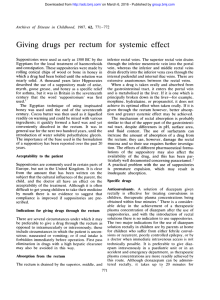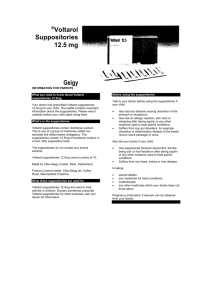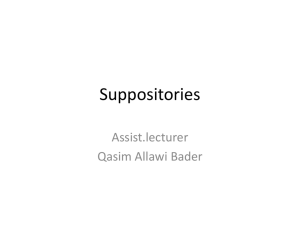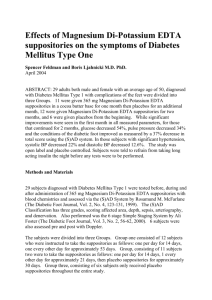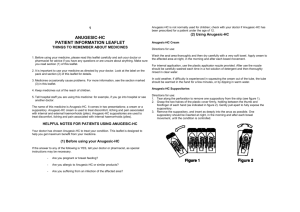Topic of lecture:
advertisement
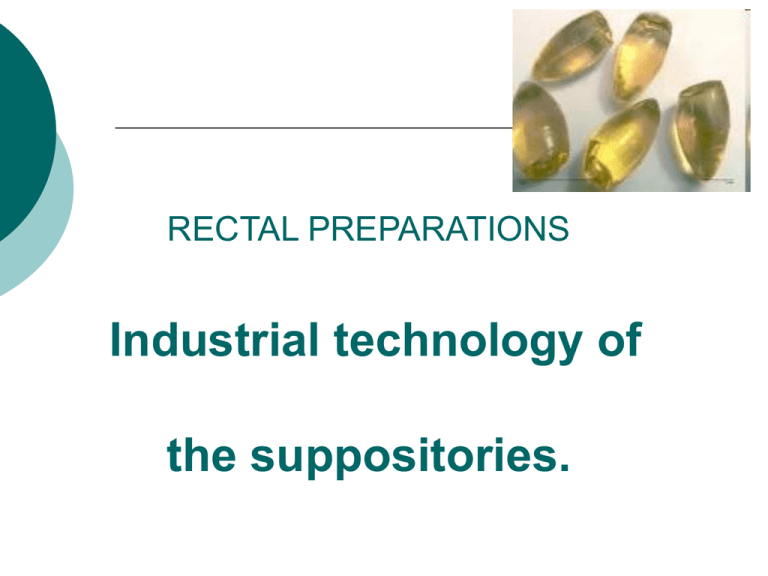
RECTAL PREPARATIONS Industrial technology of the suppositories. Plan 1. Rectal preparations. Classification of the rectal preparations. 2. Suppositories. General characteristic of suppositories. 3. Methods of suppositories production in industrial. 4. Equipments for suppositories production in industrial. 5. Standardization of suppositories. Rectal preparations are intended for rectal use in order to obtain a systemic or local effect, or they may be intended for diagnostic purposes. Where applicable, containers for rectal preparations comply with the requirements for Materials used for the manufacture of containers and Containers. Several categories of rectal preparations: suppositories, rectal capsules, rectal solutions, emulsions and suspensions, powders and tablets for rectal solutions and suspensions, semi-solid rectal preparations, rectal foams, rectal tampons. Suppositories – dosage form which are solid at room temperature and melting or dissolving at body temperature are intended for administration in the body cavity. Suppositories are solid, single-dose preparations. The shape, volume and consistency of suppositories are suitable for rectal administration. Rectal capsules (shell suppositories) are solid, single-dose preparations generally similar to soft capsules as defined in the monograph on Capsules except that they may have lubricating coatings. They are of elongated shape, are smooth and have a uniform external appearance. Rectal solutions, emulsions and suspensions are liquid preparations intended for rectal use in order to obtain a systemic or local effect, or they may be intended for diagnostic purposes. Rectal solutions, emulsions and suspensions are supplied in single-dose containers and they contain one or more active substances dissolved or dispersed in water, glycerol or macrogols or other suitable solvents. Emulsions may show evidence of phase separation but are readily redispersed on shaking. Suspensions may show a sediment which is readily dispersible on shaking to give a suspension which remains sufficiently stable to enable the correct dose to be delivered. Powders and tablets intended for the preparation of rectal solutions or suspensions are single-dose preparations which are dissolved or dispersed in water at the time of administration. They may contain excipients to facilitate dissolution or dispersion or to prevent aggregation of the particles. After dissolution or suspension, they comply with the requirements for rectal solutions or rectal suspensions, as appropriate. Semi-solid rectal preparations are ointments, creams or gels. They are often supplied as single-dose preparations in containers provided with a suitable applicator. Semi-solid rectal preparations comply with the requirements of the monograph on Semi-solid preparations for cutaneous application. Semi-solid preparations for cutaneous application are intended for local or transdermal delivery of active substances, or for their emollient or protective action. They are of homogeneous appearance. Rectal tampons are solid, single-dose preparations intended to be inserted into the lower part of the rectum for a limited time. Suppositories contain one or more active substances dispersed or dissolved in a suitable basis which may be soluble or dispersible in water or may melt at body temperature. Excipients such as diluents, adsorbents, surface-active agents, lubricants, antimicrobial preservatives colouring matter authorised by the competent authority, may be added if necessary. Classification a. Rectal suppositories for adults weigh 2 gm and are torpedo shape. Children's suppositories weigh about 1 gm. b. Vaginal suppositories or Pessaries weigh about 3-5gm and are moulded in globular or oviform shape or compressed on a tablet press into conical shapes. c. Urethral suppositories called bogies are pencil shape. Those intended for males weigh 4 gm each and are 100-150 mm long while those for females are 2 gm each and 60-75 mm in length. Advantages of suppositories: 1. Suppositories are precise dosage forms containing accurate quantities of medicament(s). 2. Suppositories have been used for systemic distribution when the oral administration was not suitable, as in unconscious patients and infants. Suppositories simplify or eliminate the problem of infant medication. 3. Suppositories allow administration of some medicaments, which are not tolerated orally, e.g. medicaments which are sensitive to the gastric pH and gastric enzymes. Advantages of suppositories: 4. Suppositories permit administration of medicament that interrupt the functionality of the gastrointestinal tract e.g. drugs irritating to the stomach. 5. Suppositories are useful when the stomach is not the ideal position to receive medication such as in case of nausea and vomiting. 6. Suppositories are suitable when local effect is wanted as in the treatment of rectal, vaginal and urethral diseases. 7. Suppositories have shown faster onset of action than found after oral administration as the drug is directly absorbed from the mucosa into the venous circulation. Advantages of suppositories: 8. Drugs destroyed by portal circulation may bypass the liver circulation, where many drugs subject to metabolic changes (first pass effect). Disadvantages of Suppositories: 1. The problem of patient acceptability. 2. Suppositories are not suitable for patients suffering from diarrhea. 3. In some cases the total amount of the drug must be given will be either too irritating or in greater amount than reasonably can be placed into suppository. 4. Incomplete absorption may be obtained because suppository usually promotes evacuation of the bowel. On the speed of absorption of drugs with suppositories such physiological factors affect: 1. State of the rectum. 2. Circulation of blood suction surface. 3. Muscle tone and mucus layer on the surface of the walls of the rectum. 4. - Nature of the basis is the most influential factor on the absorption of active ingredients from suppositories. Requirements to suppository bases: 1. They must retain sufficient hardness at room temperature. 2. Temperature of melting or dissolution must be close to the temperature of the human body. 3. Should not irritate the mucous membrane of the rectum and cause other undesirable activities that should be physiologically neutral. 4. Should not prevent the release and the therapeutic act of medicinal substances. 5. Should not interact with drugs, which administered in the suppository mass. Technological requirements to suppository bases: 1. Chemical and physical stability of the base during manufacture and storage of suppositories; 2. Ability to easily form and maintain the necessary hardness when you enter; 3. Ability emulsify required number of solutions; 4. Have some plasticity, viscosity, total time of deformation, that certain structural and mechanical properties. Methods of suppositories production in industrial 1. Fusion Moulding 2. Compression Moulding Hand molding is used only in the pharmacy! Method Fusion Moulding It involves first melting the suppository base, and then dispersing or dissolving the drug in the melted base. The mixture is poured into a suppository mold. When the mixture has congealed, the suppositories are removed from the mold. The fusion method can be used with all types of suppositories and must be used with most of them. Technological stages of industrial production of suppositories by fusion moulding 1) Production of bases; 2) Preparation of drugs and obtaining concentrate; 3) Introduction drugs in the base; 4) Formation (and packing) suppositories; 5) Packing of suppositories. Stage of production bases: 1. Weighing components of the base. 2. In stainless steel reactor with a steam jacket and stirrer components of base are alloyed at 6070°C and stirring for 40 minutes. 3. The base is filtered through a druc-filter, using brass mesh or belting, and analyzed by point of the melting, solidification and times of total deformation. 4. Then it is transferred to the hardware department. Preparation of drugs and obtaining concentrate 1. Making of the solution or suspension of medicines: - Water-soluble components are dissolved in water, heated to 45 °C, - Fat soluble components are dissolved in part of the molted fat base. - Substances insoluble in water and base, are used as suspension: Pre-crushed medicines are mixed in a reactor with an equal number of base (or one and half), heated to temperature of 40-50 °C. Preparation of drugs and obtaining concentrate 2. The obtained concentrate is cooled and grinded by colloid miller or for thermolabile substances - by three rolls ointment rubber. Furthermore, for obtaining high quality suspensions rotary-pulsation apparatus, rotary-screw pumps and other equipment can be used. 3. These concentrates are filtered through calico, and then mixed with the rest of the base. Introduction medicines in the bases Ready to concentrate is poured by the pump (through a hose caprone sieve) into reactor (with an anchor stirrer or turbine) for mixing with the rest of base. Stage of formation and packing suppositories: Lines such as «Sarong 200 S» with direct dosing of formed mass in the cells are formed of polyvinylchloride films is used for fesion suppositories with followed styling of products in bundles. Sarong/SAAS 6 - AP/VP Switzerland (Hünenberg) Sarong/SAAS 6 - AP/VP Switzerland (Hünenberg) Sarong/SAAS 6 - AP/VP Switzerland (Hünenberg) for PVC/PE and PVC/PVCDC/PE and other thermoforming materials, output max. 12.000 supp./h, two stage (cooling time 16 min. = 2 x 8 min.) 4 format sets for suppositories: 1,07 ml, 1,25 ml, 2,2 ml and 2,5 ml jacketed melting vessel 80 ltr. with anchor stirrer, peristaltic pump D-200, cooling unit 7500W/h, knurling, coding, perforation and cutting stations, Cooling unit with closed water circuit for external installation. Stage of formation suppositories: 1. From the two vertical set rolls aluminium foil tapes or polyvinylchloride films are served. 2. Then both tapes are formed in bowl-like halves, which are connected in to the complete form and heat-sealed at the temperature. At the top of each form hole remains open for filling by a needle for filling, which pours on molten suppository mass. Thus, a formed from foil packaging is simultaneously used by fusion moulds. 3. On the next position packaging is hermetically sealed. From the two vertical set rolls aluminium foil tapes or polyvinylchloride films are served. Disadvantage of the fusion method: 1. It's possible a bundle of suppository mass into separate layers during the measuring and harden especially in cases of the insoluble ingredients with a large density or fluid that are not mixed with water present. 2. This method is not suitable for thermolabile substances. To prevent bundle of suppository mass: 1. You must to increase the viscosity of the base. 2. Avoid high temperature at the fusion of the mass. 3. Carry out mixing of the mass before fusion in the mould. The method of compressing is nonthermal method of suppositories producing by compressing of cooled mass and crushed the mix of the base and drugs. Compression Molding It is a method of preparing suppositories from a mixed mass of grated suppository base and medicaments which is forced into a special compression mold. The method requires that the capacity of the molds first be determined by compressing a small amount of the base into the dies and weighing the finished suppositories. When active ingredients are added, it is necessary to omit a portion of the suppository base, based on the density factors of the active ingredients. Compression Molding 1. Suppository mass is usually cooled in the refrigerator to 3 - 5 °C, 2. Cooled suppository mass is crushed and sifted. 3. Excipients (lactose, sucrose, aerosil and starch) are added to the composition of granules for correction technological properties. 4. Compression of the suppositories. The advantages of compressing method: 1. Is the ability to prevent the destruction of thermostable drugs, lack of sedimentation of the active ingredient and avoid possible incompatibility with the molten suppository base. This method is applicable when using plastic bases. 2. In production of pressed suppositories do not need to exert considerable efforts to eject because the fat particles act as an effective base oils in the wall layer as a result of severe plastic leakage. The advantages of compressing method: 3. Pressing method is particularly suitable in the production of suppositories with cardiac glycosides, some thermostable hormones, biogenic stimulators, because the production process to yield high precision dosing, thermal stability of drugs/ Standardization of suppositories 1. Description 2. Identification and quantitative determination of active substances and antimicrobial preservatives 3. Average mass and uniformity of mass 4. Disintegration 5. Uniformity of content 6. Melting point or a full strain 7. Dissolution 8. Impurities 9. Microbiological purity 10. If necessary, additional control acid and peroxide numbers 11. Particle size Quality control of suppositories: 1- Appearance: This includes odour, colour, surface condition and shape. 2- Weight Uniformity: - Weigh 20 suppositories individually. w1, w2, w3….w20 - Weigh all the suppositories together = W. - Calculate the average weight = W/20. Limit: Not more than 2 suppositories differ from the average weight by more than 5%, and no suppository differs from the average weight by more than 10%. Quality control of suppositories: 3- Melting range test: - Determines the time taken by an entire suppository to melt when it is immersed in a constant temperature bath at 37°C. -The experiment done by using the USP Tablet Disintegration Apparatus. Procedure: 1-The suppository is completely immersed in the constant temperature water bath, and the time for the entire suppository to melt or disperse in the surrounding water is measured. - The suppository is considered disintegrated when: A- It is completely dissolved or B- Dispersed into its component part. C- Become soft “change in shape” with formation of core which is not resistant to pressure with glass rod. Quality control of suppositories: 4- Liquefaction Time or Softening Time Test: - In this test a U tube is partially immersed in a constant temperature bath and is maintained at a temperature between 35 to 37°C. There is a constriction in the tube in which the suppository is kept and above the suppository, a glass rod is kept. The time taken for The glass rod to go through the suppository and reach the constriction is known as the liquefaction time or softening time. - Another apparatus is there for finding “softening time” which mimics in vivo conditions. It uses a cellophane tube, and the temperature is maintained by water circulation. Time taken for the suppository to melt is noted Quality control of suppositories: 5- Breaking Test (Hardness): - The breaking test is designed as a method for measuring the fragility or brittleness of suppository. 1-The suppository is placed in the instrument. 2- Add 600 g; leave it for one min. (use a stop watch). 3- If not broken, add 200 g every one min. until the suppository is broken. Calculations: The hardness of the suppository is calculated by adding the weights together. But if the suppository is broken before the end of the last min. the last weight is canceled. Quality control of suppositories: 6- Dissolution test: - By using different types of apparatus such as wire mesh basket, or dialysis tubing is used to test for in vitro release from suppositories. Quality control of suppositories: 7- Stability testing: -Cocoa butter suppositories on storage, “bloom”; i.e., they form a white powdery deposit on the surface. This can be avoided by storing the suppositories at uniform cool temperatures and by wrapping them in foils. - Fat based suppositories harden on storage, i.e., there is an upward shift in melting range due to slow crystallization to the more stable polymorphic forms of the base. - The softening time test and differential scanning calorimetry can be used as stability indicating test methods. - If we store the suppositories at an elevated temperature, just below its melting range, immediately after manufacture, the aging process is speeded up. Directions of suppositories improving : 1. Lyophilized suppositories 2. Porous suppositories 3. Multilayered suppositories 4. Suppositories with film-coated 5. Painted suppositories
